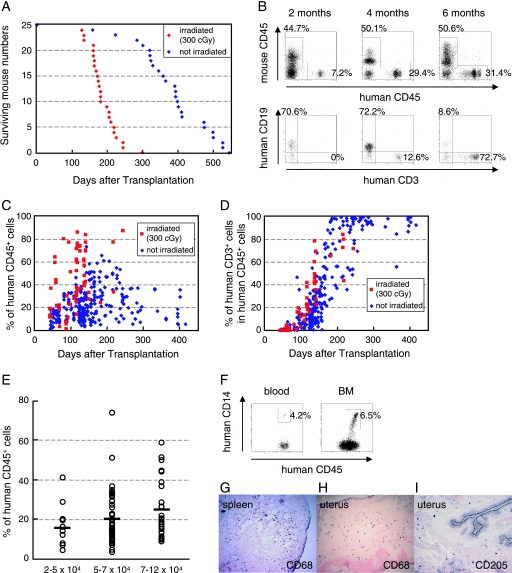FIG. 1.
Human cell generation in hematopoietic stem cell-engrafted hNOG mice with or without myeloablation. (A) Life spans of NOG mice transplanted with human stem cells after receiving 300 cGy irradiation (n = 25) or not receiving irradiation (n = 25). (B) Representative flow cytometric profiles of the mice from 2 to 6 months after transplantation without irradiation. The ratio of human to murine CD45+ cells and that of human CD3+ cells to CD19+ cells are shown. Note that the mice generated human CD45+ leukocytes that eventually developed human CD19+ B cells first and then CD3+ T cells. (C and D) Percentages of human CD45+ cells (C) and CD3+ T cells in human CD45+ cells (D) in peripheral blood from 65 mice that received 300 cGy irradiation and 222 nonirradiated mice 40 to 413 days after transplantation. (E) Summary of engraftment levels in nonirradiated mice transplanted with 2 × 104 to 5 × 104 cells (n = 11), 5 × 104 to 7 × 104 cells (n = 53), or 7 × 104 to 12 × 104 (n = 30) human stem cells. Percentages of human CD45+ leukocytes in peripheral blood during 4 to 5 months after transplantation were shown. The horizontal black bars indicate the averages of the groups. (F to I) Flow cytometric analysis and immunohistochemical analysis of the expression of myelomonocytic markers in nonirradiated mice 4 months after transplantation. Human CD14+ monocytes/macrophages were recognized in peripheral blood and BM (F). A gate was set on the human CD45+ population. Human CD68+ macrophages and CD205+ DCs were also detected in spleen (G) and uterus (H and I). Visualization was performed with 5-bromo-4-chloro-3-indolylphosphate (BCIP). The original magnifications were ×100 (G and H) and ×200 (I).

